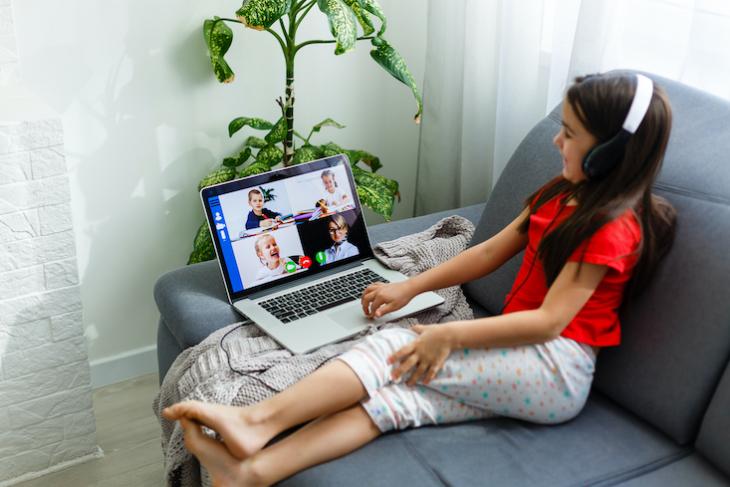My experience teaching in China during the pandemic put me in a unique position.
I’m a foreign teacher who not only experienced the rise of the pandemic first hand, but I was a part of the first wave of teachers who made the switch to online teaching.
For years teachers have been encouraged to start integrating technology into our classroom as a way to increase student engagement and prepare our kids to be 21st-century learners.
But many of us (myself included) never thought of the possibility of a paradigm shift from integrating technology into the classroom to being 100% online. And, especially not overnight.
And without any notice or preparation, teachers like me were left to improvise.
But I was able to do it, and so can you. Through this unusual journey, I’ve gained new skills and strategies for online learning that I wouldn’t have learned otherwise. And I want to share those with you.
In this post, I will be offering you some useful tips on how to bridge the gap from a classroom teacher to teaching in an online environment. Some topics that I’ll cover are:
- Embracing the new reality.
- Connecting to your support systems.
- Empathizing with your students.
- Using online tech tools and apps.
- Integrating traditional classroom best practices.
Let’s dig into it!

Embracing the new reality.
We all come from different parts of the world and the COVID-19 virus has impacted us all.
Some of us are just starting the transition, while others made the transition months ago. Teaching in China during a pandemic was challenging, to say the least. All of us teachers around the world have had to redefine the way we teach.
When I first arrived in China, I was teaching at an international school. We made the switch to online schooling in the first week of February.
For each school, online classrooms might look very different depending on your school’s resources and current online platform.
Communicate with your administration to make sure that you are using the appropriate online technology/platform. This will ensure that your students will have equitable access to the content and it fits with your lesson plans.
Communication is essential, as many of us have different online tech tools that we are comfortable using. Still, we want to make sure we align with our school as best as possible to decrease the anxiety level for our students and parents.
Connecting to your support systems.
Transitioning to online schooling is not easy. We’ve seen so many memes that we can relate to when it comes to the challenges of using online platforms.
And after the short laugh, we sometimes wonder:
- How are we going to do this?
- Am I capable of being a successful online teacher?
You’re not alone. That’s why it’s important to find a support system of colleagues who you can share your struggles and successes with.
As teachers, we are masters of our classroom. But now that we are online, it can feel so overwhelming that we forget to do what we always tell our students to do when they’re struggling: ask for help.
I’ve received so much support from other teachers who I would never have regarded as tech gurus. But open dialogue has allowed me to steal a trick here or there that has enhanced the classroom experience for my students.
I have also noticed that my anxiety level has gone down after collaborating with my colleagues as it allows you to see that none of us are perfect. Everyone has struggled in one way or another with their experience teaching online.
Don’t be afraid to reach out to your coworkers for support. Know that you’re in good company.

Empathize with your students.
The transition to an online classroom can be difficult for us teachers, but it can be equally difficult for our students and parents.
As a parent of a kindergartener, I found working with my son to be just as challenging as teaching my students.
Trying to manage all the different lessons while keeping him on task and focused has not been easy.
This got me thinking about how my students must feel when completing their assigned work. Especially those that do not have parent help readily available at home or resources such as laptops, tablets, and the internet.
When I first started teaching online, I wanted to provide my students with the same resources that we would have covered in a normal class period. For me, it was important that my students still received the same amount of rigor and content as they would in our everyday class.
However, that mindset quickly shifted.
My students started to feel overwhelmed with the amount of work, to the point where many stopped turning in work altogether.
We were encouraged by our administration to send out online surveys to our students. I was blown away by how much time students said they were spending on my class (responses varied from 3 to 5 hours a day). This was way more than I intended.
It is much easier to gage pacing in your classroom where you can check in with all your students frequently.
I had to shift my thinking and not eliminate the rigor, but decrease the amount of work while increasing the quality of my feedback to my students.
After I made that change, I started to see a sharp increase in the quality of my students’ completed work and engagement in my classes.
If you have not sent out a survey, I highly recommend it. I just caution you to use the survey data to self reflect and not get discouraged by the results if they are not what you expected.

Using online tech tools and apps.
Here are some of my favorite tech tools with guidance from my school.
I am going to break these up into two categories asynchronous learning (non-live classes) and synchronous learning (live class sessions). My school started fully asynchronous as most of our teachers were not in the same timezone as many of our students.
Asynchronous learning:
Screencast-O-Matic
Super user friendly and by far my most used tech tool. It allows you to record and upload your tutorials.
You can choose to do face to face or switch to mirroring your computer screen to go over handouts, powerpoints, and word documents.
CK-12
CK-12 is another great resource for online readings and videos. It has units for and resources for almost every subject and grade level and follows the Next Generation Science Standards and Common Core.
It’s especially useful for EAL students. All articles can be translated into their native language to allow them to access the content better, and the videos also have subtitles in a variety of languages.
After two months of asynchronous learning, our school switched to a blended learning model of synchronous and asynchronous learning. The combination, in my opinion, has been the most beneficial for our students.
Depending on your school’s chosen online platform, you can use a variety of tools.
Synchronous Learning
Microsoft 365 & Microsoft Teams
These platforms have been a game-changer as we have a live class option where I can meet with students and conduct class.
Students can submit their work and I can provide them with written or oral feedback. You can also set up discussion boards for students to comment on each other’s work.
Zoom
Zoom is another online meeting option, and it integrates with Microsoft 365. It gives you the ability to see all of your students at one time and is easy to break into small groups to collaborate.
It is also helpful since it allows you to see all your students while taking a test to increase test security.
Those are just a few great tools to get you going if your school approves them. These are the tools I found to be the most user-friendly. Before you try anything, make sure your school is ok with it first.

Integrating classroom best practices.
Having a positive classroom culture that encourages student-to-student collaboration is one thing we all strive to do when in the classroom. However, it is hard to maintain while online.
Here’s what I did to blend in traditional classroom strategies into the online environment.
Encouraging smaller groups for discussion.
Some strategies that I have used with the tech tools mentioned above are providing students with some independent work while meeting with smaller groups of students for 10 to 15 minutes.
After conducting a short survey with my class, I found that students felt it was intimidating to give a response for all the class to hear.
Once I started meeting with small groups, I found I had much more student engagement when we went to whole group discussions.
Utilizing discussion boards.
Another option I found helpful has been discussion boards to allow students the opportunity to comment and critique each other’s work.
First, I had to include some guiding questions around how to give positive, constructive feedback. And as time has gone on, students have gotten much better at providing quality feedback to each other.
Making sure tests are secure.
A big struggle at our school is the idea of test security.
One way I have combated that is to have my students write the tests. They not only have to write the questions, but also provide the expected answer and explain how it relates to the standard.
They get a score based on the difficulty of their questions. I have been blown away by the quality of questions students have come up with.
I have then used questions from different classes to create multiple versions of assessments to increase the difficulty of looking up and sharing answers.
Do your best.
Is teaching online easy? No, it is tough but I look at this experience as a parallel to my first couple of years as a new teacher.
I was not perfect and I was not confident, but I cared for my kids. If you communicate empathy to your students and can put yourself in their shoes, they will reciprocate.
Know that you will only get better as time goes on, and once we are reunited in our schools.
We will have a whole new set of skills that will allow us to integrate technology in our classrooms and truly be able to prepare our students to be 21st-century learners.
And, if you need a little more help, there’s great training available for teachers around creating effective online classrooms for your students.



